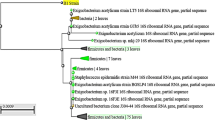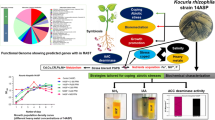Abstract
Duckweed has shown great potential for both energy and environmental applications, particularly in wastewater treatment and fuel ethanol production. A rhizobacterium, Exiguobacterium sp. MH3, has been reported to associate with the duckweed Lemna minor for symbiotic growth. The aim of this work is to study the effects of rhizobacterium MH3 on L. minor growth and chromium (Cr) remediation. It appeared to have a synergism between the rhizobacterium MH3 and duckweed; the presence of strain MH3 promoted the growth of duckweeds by increasing both the frond number and dry weight of duckweed by more than 30 %, while duckweed in turn provided essential carbon source and energy for the growth of rhizobacterium MH3. Under Cr(VI) exposure, particularly at higher Cr(VI) concentrations, Exiguobacterium sp. MH3 significantly alleviated the harmful effects of the stress on the duckweed by promoting duckweed growth and preventing duckweed from excessive uptake of Cr. Potential mechanisms were also discussed in light of the genome sequence of strain MH3, and it was speculated that siderophores and indole-3-acetic acid (IAA) secreted by strain MH3 might contribute to promoting duckweed growth.



Similar content being viewed by others
References
Abdallah MAM (2011) Phytoremediation of heavy metals from aqueous solutions by two aquatic macrophytes, Ceratophyllum demersum and Lemna gibba L. Environ Technol 33:1609–1614
Appenroth K-J, Keresztes Á, Sárvári É, Jaglarz A, Fischer W (2003) Multiple effects of chromate on Spirodela polyrhiza: electron microscopy and biochemical investigations. Plant Biol 5:315–323
Axtell NR, Sternberg SPK, Claussen K (2003) Lead and nickel removal using Microsporaand Lemna minor. Bioresour Technol 89:41
Bharti N, Yadav D, Barnawal D, Maji D, Kalra A (2013) Exiguobacterium oxidotolerans, a halotolerant plant growth promoting rhizobacteria, improves yield and content of secondary metabolites in Bacopa monnieri (L.) Pennell under primary and secondary salt stress. World J Microbiol Biotechnol 29:379–387
Biedermann KA, Landolph JR (1990) Role of valence state and solubility of chromium compounds on induction of cytotoxicity, mutagenesis, and anchorage independence in diploid human fibroblasts. Cancer Res 50:7835
Burd GI, Dixon DG, Glick BR (2000) Plant growth-promoting bacteria that decrease heavy metal toxicity in plants. Can J Microbiol 46:237–245
Cheng JJ, Stomp A (2009) Growing duckweed to recover nutrients from wastewaters and for production of fuel ethanol and animal feed. Clean: Soil Air Water 37:17–26
Dastager SG, Kumaran DC, Pandey A (2010) Characterization of plant growth-promoting rhizobacterium Exiguobacterium NII-0906 for its growth promotion of cowpea (Vigna unguiculata). Biologia 65:197–203
Debusk TA, Laughlin RB, Schwartz LN (1996) Retention and compartmentalization of lead and cadmium in wetland microcosms. Water Res 30:2707–2716
Drost W, Matzke M, Backhaus T (2007) Heavy metal toxicity to Lemna minor: studies on the time dependence of growth inhibition and the recovery after exposure. Chemosphere 67:36–43
Hou WH, Chen X, Song GL, Wang QH, Chang CC (2007) Effects of copper and cadmium on heavy metal polluted waterbody restoration by duckweed (Lemna minor). Plant Physiol Biochem 45:62–69
Isaksson R, Balogh SJ, Farris MA (2007) Accumulation of mercury by the aquatic plant Lemna minor. Int J Environ Stud 64:189–194
Joseph B, Patra RR, Lawrence R (2007) Characterization of plant growth promoting rhizobacteria associated with chickpea (Cicer arietinum L.). Int J Plant Prod 1:141–151
Khan M, Zaidi A, Wani P, Oves M (2009) Role of plant growth promoting rhizobacteria in the remediation of metal contaminated soils. Environ Chem Lett 7:1–19
Khellaf N, Zerdaoui M (2010) Growth response of the duckweed Lemna gibba L. to copper and nickel phytoaccumulation. Ecotoxicology 19:1363–1368
Kristanti RA, Kanbe M, Toyama T, Tanaka Y, Tang YQ, Wu XL, Mori K (2012) Accelerated biodegradation of nitrophenols in the rhizosphere of Spirodela polyrrhiza. J Environ Sci 24:800–807
Lemanceau P, Bauer P, Kraemer S, Briat J-F (2009) Iron dynamics in the rhizosphere as a case study for analyzing interactions between soils, plants and microbes. Plant Soil 321:513–535
Lone MI, He ZL, Stoffella PJ, Yang XE (2008) Phytoremediation of heavy metal polluted soils and water: progresses and perspectives. J Zhejiang Univ Sci B 9:210–220
Maine MA, Duarte MV, Suñé NL (2001) Cadmium uptake by floating macrophytes. Water Res 35:2629–2634
Megateli S, Semsari S, Couderchet M (2009) Toxicity and removal of heavy metals (cadmium, copper, and zinc) by Lemna gibba. Ecotoxicol Environ Saf 72:1774–1780
Naumann B, Eberius M, Appenroth KJ (2007) Growth rate based dose-response relationships and EC-values of ten heavy metals using the duckweed growth inhibition test (ISO 20079) with Lemna minor L. clone St. J Plant Physiol 164:1656–1664
Oporto C, Arce O, Van den Broeck E, Van der Bruggen B, Vandecasteele C (2006) Experimental study and modelling of Cr (VI) removal from wastewater using Lemna minor. Water Res 40:1458–1464
Panda J, Sarkar P (2012) Bioremediation of chromium by novel strains Enterobacter aerogenes T2 and Acinetobacter sp PD 12 S2. Environ Sci Pollut Res 19:1809–1817
Prasad MNV, Malec P, Waloszek A, Bojko M, Strzalka K (2001) Physiological responses of Lemna trisulca L. (duckweed) to cadmium and copper bioaccumulation. Plant Sci 161:881–889
Rahmani GNH, Sternberg SPK (1999) Bioremoval of lead from water using Lemna minor. Bioresour Technol 70:225–230
Rai PK (2009) Heavy metal phytoremediation from aquatic ecosystems with special reference to macrophytes. Crit Rev Env Sci Technol 39:697–753
Rehman A, Zahoor A, Muneer B, Hasnain S (2008) Chromium tolerance and reduction potential of a Bacillus sp.ev3 isolated from metal contaminated wastewater. Bull Environ Contam Toxicol 81:25–29
Selvakumar G, Kundu S, Joshi P, Nazim S, Gupta AD, Gupta HS (2010) Growth promotion of wheat seedlings by Exiguobacterium acetylicum 1P (MTCC 8707) a cold tolerant bacterial strain from the Uttarakhand Himalayas. Indian J Microbiol 50:50–56
Srivastava S, Thakur IS (2012) Biosorption and biotransformation of chromium by Serratia sp. isolated from tannery effluent. Environ Technol 33:113–122
Stout LM, Dodova EN, Tyson JF, Nüsslein K (2010) Phytoprotective influence of bacteria on growth and cadmium accumulation in the aquatic plant Lemna minor. Water Res 44:4970–4979
Tang J, Zhang Y, Meng H, Xue Z, Ma J (2013) Complete genome sequence of Exiguobacterium sp. strain MH3, isolated from rhizosphere of Lemna minor. Genome Announc 1, e01059–01013
Tang J, Zhang F, Cui W, Ma J (2014) Genetic structure of duckweed population of Spirodela, Landoltia and Lemna from Lake Tai, China. Planta 239:1299–1307
Toyama T et al (2009) Enrichment of bacteria possessing catechol dioxygenase genes in the rhizosphere of Spirodela polyrrhiza: a mechanism of accelerated biodegradation of phenol. Water Res 43:3765–3776
Üçüncü E, Tunca E, Fikirdeşici Ş, Altındağ A (2013a) Decrease and increase profile of Cu, Cr and Pb during stable phase of removal by duckweed (Lemna minor L.). Int J Phytorem 15:376–384
Üçüncü E, Tunca E, Fikirdeşici Ş, Özkan A, Altındağ A (2013b) Phytoremediation of Cu, Cr and Pb mixtures by Lemna minor. Bull Environ Contam Toxicol 91:600–604
Uysal Y (2013) Removal of chromium ions from wastewater by duckweed, Lemna minor L. by using a pilot system with continuous flow. J Hazard Mater 263(Part 2):486–492
Varga M, Horvatić J, Čelić A (2013) Short term exposure of Lemna minor and Lemna gibba to mercury, cadmium and chromium. Cent Eur J Biol 8:1083–1093
Wu S, Feng X, Wittmeier A (1997) Microwave digestion of plant and grain reference materials in nitric acid or a mixture of nitric acid or a mixture of nitric acid and hydrogen peroxide for the determination of multi-elements by inductively coupled plasma mass spectrometry. J Anal Atom Spectrom 12:797–806
Xu JL, Cui WH, Cheng JJ, Stomp AM (2011) Production of high-starch duckweed and its conversion to bioethanol. Biosyst Eng 110:67–72
Yamaga F, Washio K, Morikawa M (2010) Sustainable biodegradation of phenol by Acinetobacter calcoaceticus P23 isolated from the rhizosphere of duckweed Lemna aoukikusa. Environ Sci Technol 44:6470
Zhang Y, Shi P, Ma J (2013) Exiguobacterium spp. and their applications in environmental remediation: Exiguobacterium spp. and their applications in environmental remediation. Chin J Appl Environ Biol 19:898–904
Zhang Y, Zhang YY, Tang J, Ma J (2014) Characterization of reduction of hexavalent chromium by Exiguobacterium sp. MH3. Chin J Appl Environ Biol 20:791–797
Acknowledgments
This research was funded by a Key Project of Shenzhen Emerging Industries to JM (No. JC201104210118A) and Public Science and Technology Research Funds Projects of Ocean (201305022). Authors would like to kindly acknowledge Eric Lam for providing Lemna minor 145 and Maurycy Daroch for valuable comments on the manuscript.
Conflict of interest
The authors declare that they have no conflict of interest.
Author information
Authors and Affiliations
Corresponding author
Additional information
Responsible editor: Elena Maestri
Jie Tang and Ying Zhang contributed equally to this work.
Rights and permissions
About this article
Cite this article
Tang, J., Zhang, Y., Cui, Y. et al. Effects of a rhizobacterium on the growth of and chromium remediation by Lemna minor . Environ Sci Pollut Res 22, 9686–9693 (2015). https://doi.org/10.1007/s11356-015-4138-y
Received:
Accepted:
Published:
Issue Date:
DOI: https://doi.org/10.1007/s11356-015-4138-y




